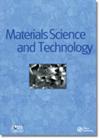Co/P微合金化对Cu-15Ni-8Sn合金应力松弛行为的影响
IF 2.2
4区 材料科学
Q3 MATERIALS SCIENCE, MULTIDISCIPLINARY
引用次数: 0
摘要
为了提高Cu-5Ni-S8n合金的抗应力松弛性能,采用扫描电镜、透射电镜、电子背散射衍射、x射线衍射和高温蠕变耐久性试验研究了Co或P的加入对Cu-5Ni-S8n合金抗应力松弛性能的影响。结果表明,随着温度的升高,弛豫速率显著增加。Co的加入显著提高了Cu-15Ni-8Sn合金的抗热应力松弛性能;Cu-15Ni-8Sn合金在200℃和250℃下进行应力松弛试验100 h后,Co的加入使Cu-15Ni-8Sn合金的残余应力值分别增加了23 MPa和22 MPa,这与Co原子对空位的消耗和Co原子对位错的钉住作用有关。然而,在250℃时,Cu-15Ni-8Sn-0.2 2p合金的抗应力松弛性低于Cu-15Ni-8Sn合金。这种差异是由于P的加入促进了再结晶反应。再结晶和位错密度的降低是导致试样应力松弛的主要原因。Co的加入显著提高了Cu-15Ni-8Sn合金的抗应力松弛性能。P元素的加入不利于热应力松弛性的提高。本文章由计算机程序翻译,如有差异,请以英文原文为准。
Effect of Co/P micro-alloying on stress relaxation behaviour of Cu-15Ni-8Sn alloy
To improve the stress relaxation resistance of the Cu-5Ni-S8n alloy, the effects of Co or P addition on its stress relaxation resistance were investigated by scanning electron microscopy, transmission electron microscopy, electron backscatter diffraction), X-ray diffraction, and high-temperature creep durability tester. The results revealed that the relaxation rate increased dramatically as the temperature rose. The thermal stress relaxation resistance of Cu-15Ni-8Sn alloy was significantly improved with Co addition; After 100 h of stress relaxation tests at 200°C or 250°C, the residual stress value of the Cu-15Ni-8Sn alloy increased by 23 MPa or 22 MPa with Co addition, which was associated with the consumption of vacancies by Co atoms and the pinning effect of Co atoms on dislocation. However, at 250°C, the stress relaxation resistance of the Cu-15Ni-8Sn-0.2P alloy was lower than that of the Cu-15Ni-8Sn alloy. This difference was due to the inclusion of P, which promoted the recrystallization reaction. Article highlights Recrystallization and the decrease of dislocation density are the major reasons for the stress relaxation of the samples. The stress relaxation resistance of Cu-15Ni-8Sn alloy was significantly improved with Co addition. The addition of the P element is not conducive to the improvement of thermal stress relaxation resistance.
求助全文
通过发布文献求助,成功后即可免费获取论文全文。
去求助
来源期刊

Materials Science and Technology
工程技术-材料科学:综合
CiteScore
2.70
自引率
5.60%
发文量
0
审稿时长
3 months
期刊介绍:
《Materials Science and Technology》(MST) is an international forum for the publication of refereed contributions covering fundamental and technological aspects of materials science and engineering.
 求助内容:
求助内容: 应助结果提醒方式:
应助结果提醒方式:


